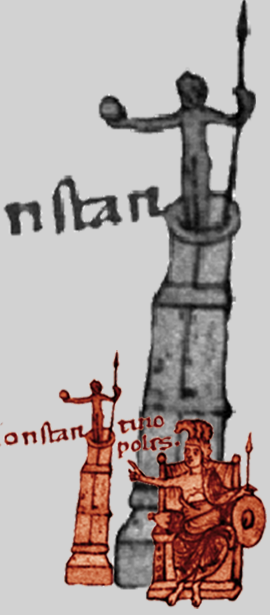Euchologia-Project
Byzantine prayer books (euchologia) contain—in addition to the major liturgies of the eucharist and sacraments— a vast number of ‘occasional prayers’ pronounced by the clergy for various occasions that address the concerns of all levels of society, regardless of social and economic status. Yet, they have gone largely unexplored as a source for daily life and social history.
The Vienna Euchologia Project (VEP) takes a two-pronged approach that employs a combination of focused thematic research with Grundlagenforschung. Several individual research projects exemplify the potential of this source material, while also establishing methodological approaches: prayers connected to historical events; the manuscript transmission of euchologia as a reflection of regional communities; the formation of organized lay piety; the history of education within an ecclesiastical framework; the experience of women in pregnancy and childbirth.
To put these thematic investigations on a firm foundation of evidence, the Project is working on a census of relevant manuscripts, which will serve as the basis for a database of prayers in prayer books in manuscript form. Both the manuscript catalogue and the database are designed to facilitate potential future research in other areas as well, such as liturgical studies.
The Sources
Euchologia are extant in Greek manuscripts beginning with the late eighth century and well into the post-Byzantine period. In the early 15th century, it was estimated that 2,000 copies of the Divine Liturgy were in circulation, but to what degree this applied to the euchologia is unknown. The exact number of extant manuscript witnesses also remains to be established. The sacramental liturgies they contain have been studied by theologians and historians of the liturgy, often on the basis of individual manuscripts. But euchologia also contain a large number of short prayers for specific occasions (hence: occasional prayers) pronounced by priests, on concerns as diverse and various as miscarriage, purifying wells, cheese-making, fishing, grape harvesting, church building or a child’s first day at school.
There is considerable variation between the manuscripts in the content, concern, and sequence of the occasional prayers. Moreover, several different prayer texts may address the same concrete concern, either scattered across different manuscripts or even within the same manuscript. At the same time, the same prayer may be reused for completely different concerns by simply changing its title or making minor modifications to the prayer text.
Unlocking the potential of the small prayers in the euchologia as a source of information for daily life and social history must begin with the manuscripts and requires a systematic, step-by-step effort of a research team over an extended period of time.
Aims of the Project
The Census of Manuscripts aims to list all extant euchologia and other relevant manuscripts, such as nomokanones, that contain occasional prayers. It is based on published materials augmented by manuscript study, either in the original or in reproductions. As of July 2019, the Catalogue includes more than 1000 manuscripts. This list is continually expanded with the aim of creating a geographical and chronological matrix upon which the euchologia of unknown provenance and date, and their prayers, can be grafted.
The catalogue will, in due course, form the basis of the open access and fully searchable Database of Prayers. Prayer texts will be linked to the manuscripts in which they are contained. Each prayer is identified by (1) its title and incipit, and (2) its content and concern. In this way, it will eventually be possible to answer questions such as: In what regions were prayers connected to viticulture or to seafaring particularly popular? What prayers specifically addressed issues of women’s health and purity? How did people join pious lay confraternities in urban settings? What is the earliest appearance of prayers related to the re-consecration of churches after they had been used by the clergy of the Latin Church? How do prayers for the re-admission of apostates develop over time?
Working Methods
For more information on our working methods on our working methods click here.
This information is work in progress and will be continuously updated.
Publications
For relevant publications of the project and its affiliates click here.
Links to video presentations of the project can be found here.
Institutional Context
The Vienna Euchologia Project (VEP) is housed at the Division of Byzantine Research in the Institute of Medieval Research of the Austrian Academy of Sciences, where it contributes to the research concentration ‘Communities and Landscapes’.
International Cooperations
PD Dr. Patrick Andrist, Ludwig-Maximilians Universität, München, Deutschland und Université de Fribourg, Schweiz
Univ.-Prof. Dr. Harald Buchinger, Universität Regensburg, Deutschland
Dr. Ágnes Mihálykó Tothne, Grant des Research Council of Norway (FRIPRO) (2020-2022)
Univ.-Prof. Dr. Martin Wallraff, Ludwig-Maximilians Universität, München, Deutschland
Funding
Basic funding, infrastructure and archiving services through the Austrian Academy of Sciences is supplemented by third-party research grants. In the past, these have been:
FWF P28219-G25 Daily Life and Religion. Byzantine Prayer Books as Sources for Social History; Claudia Rapp (PI), Eirini Afentoulidou (01.10.2015-30.9.2018), Ilias Nesseris; Stand-Alone Project, 01.10.2015-31.05.2019, €394.390,50.
FWF P 34090Liturgy, Libraries and Learning. The Evidence from Byzantine Euchologia; Claudia Rapp (PI), Ilias Nesseris (1.1.2021-31.12.2024); Stand-Alone Project, €394.775,85.
Completed Projects
Daily Life and Religion. Byzantine Prayer Books as Sources for Social History; Claudia Rapp (PI), Eirini Afentoulidou (01.10.2015-30.9.2017), Ilias Nesseris; FWF P28219-G25 Stand-Alone Project, 01.10.2015-31.05.2019, €394.390,50.
Past Events:
In Church and at Home: Byzantine Religious Life, its Sources and their Study, 7-9 April 2016
Studying Byzantine Prayer Books: Manuscripts, Liturgy, and Society, 22-23 June 2018
Conferences
"Priests and their Manuscripts in the Holy Land and Sinai", 8-10 November 2023

Contact
Claudia Rapp (project leader; Universität Wien, Institut für Byzantinistik und Neogräzistik – Österreichische Akademie der Wissenschaften, Institut für Mittelalterforschung, Abteilung Byzanzforschung)
Eirini Afentoulidou (project member)
Renate Burri (project member)
Ilias Nesseris (project member: 1.10.2015-30.08.2022)
Giulia Rossetto (project member)
Elisabeth Schiffer (project member)
Daniel Galadza (project partner; Pontificio Istituto Orientale (https://orientale.it/it/)
Links

